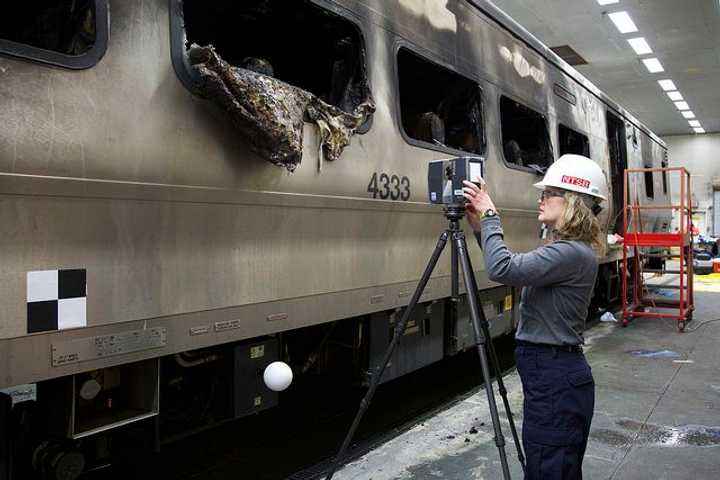The NTSB has said it could take a year to complete its full investigation of a train fire and explosion that followed a collision with a Mercedes SUV at the Commerce Street crossing. The SUV was on the track when it was struck by the northbound commuter train about 6:30 p.m. Feb. 3.
“Unfortunately, today’s report reveals no new facts about the disastrous Metro-North crash earlier this month," Blumenthal said. "I urge the NTSB and other investigators to move forward swiftly with investigating and releasing critical facts and recommendations for reform.
"The sooner we have details about this tragic incident, the sooner we can move forward with life-saving efforts that will help end the 2,000 collisions – hundreds of which are fatal – that happen annually at rail-grade crossings nationwide,” said Blumenthal.
The SUV's driver, Ellen Brody, 49, of Edgemont, N.Y., and five passengers in the lead car of the commuter train were killed.
About 20 commuters were in the first car of the train, and about 650 were on the entire train, the report said.
Much of Monday's preliminary report documented findings discussed during NTSB news conferences in Tarrytown, N.Y., earlier this month.
Monday's report said the damage from the crash was estimated by Metro-North Railroad at $3.7 million. This figure is presumably the cost of replacing damaged trains and rail lines. Metro-North officials declined to elaborate.
"We don’t have anything to add at this point, but thanks for the opportunity," said Aaron Donovan, deputy director for external communications for the Metropolitan Transit Authority, which operates Metro-North.
The five passengers killed were: Bedford Hills, N.Y., residents: Eric Vandercar, 53, and Walter Liedtke, 69; New Castle, N.Y., residents Robert Dirks, 36, and Joseph Nadol, 42; and Aditya Tomar, 41, of Danbury. All five were on their way home from work.
Witnesses reported that Brody was stopped in the crossing before the gates began lowering. When the gate lowered, it struck the rear portion of the SUV after which she exited the SUV, looked at the back of it, then got back in, drove forward and was struck by the train, according to the NTSB report.
Based on the preliminary review of the train’s event recorder data, the train was travelling at 58 mph before emergency braking and the horn was operated in accordance with operating rules, the NTSB said.
The recorder indicated that the engineer activated the emergency brakes about 300 feet before the collision after observing what he characterized as, “a vehicle partially fouling the crossing."
The train and the SUV continued northbound, resulting in the damage of the electrified third rail on the west side of the track. The third rail detached, pierced the SUV, and then entered the railcar in two locations from the underside, the NTSB said.
The NTSB will conduct a metallurgical examination of some of the third rail. Samples from the interior of the lead train car also will be examined by NTSB investigators for compliance with fire protection standards.
"It's sad that it often takes tragedy to bring people together to focus on an issue, but NTSB’s preliminary report underscores the urgency for us to act on key safety measures," said U.S. Rep. Sean Patrick Maloney (D), who represents parts of Northern Westchester and Putnam counties.
"The report underscores that (train engineer) Steven Smalls Jr. was a true hero in the face of a horrible situation; his quick reaction in slowing the train and subsequent rescue of injured passengers saved numerous lives," said U.S. Sen. Charles Schumer (D-NY). "I look forward to a full determination of the accident’s cause and final recommendations that can guide our transit systems toward a safer path."
Click here to follow Daily Voice Greenwich and receive free news updates.

